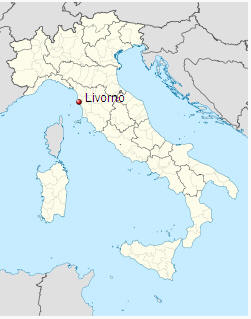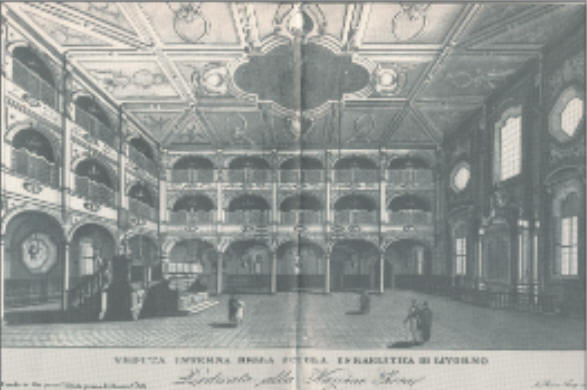



 |
 |
 |
 |
| The Venetian Quarter of Livorno showing merchants houses and canals leading to the main harbour - photograph taken Sep 2013 by Julian Land | Livorno is in Tuscany - and today serves in part as a tourist hub for cruise-ship passengers to visit Pisa, Lucca, Firenze and Siena. | The Fortezza Nuova, built on the site of a pre-Renaissance fortress, dates from Medici times at the end of the 16th century. It defended the newly-invigorated city from attack by pirates. Livorno had become attractive to Jewish merchants due to the Medici Grand Duke of Tuscany and his laws of the 1590s which meant low taxes for merchants and no Inquisition to threaten those who relinquished their New Christian past. | Interior of the synagogue of Livorno in 1642, this image appearing on p32 of Genealo-J (130) Summer 2017. Isaac Baruch Lousada #42 participated in synagogue elections around this time. The Jewish marriages of Livorno have been compiled by Cercle de Généalogie Juive (ref 319). |
From the outset of our investigations, it was clear that Livorno figured in the mini-diaspora of the Baruch Lousadas. From Amsterdam marriage data we first learned that Isaac #42 was there in 1640, with the birth in Livorno of his son David #44. And the Barrow family tree not only demonstrated a belief in the Baruch Lousada ancestry of the Barrows but also showed a Barrow & Montefiore marriage around 1735; which, as the English Montefiores did not make a permanent home in England from Livorno until 1752, suggested a Livorno Barrow origin. The 2020 publication of the Livorno Jewish marriage registers (ref 319) very usefully adds to the pioneering work of Renzo Toaff (ref 185) who documented the early years of the Jewish community of Livorno. Some clarity emerged when it became evident that the Tunis Baruch Lousadas (see note 3 below) had their origin in Livorno around 1700, and we have charted an overall picture of the Livorno Baruch Lousadas (but see note 1 and 2 below). But in the Livorno data appears neither a Barrow & Montefiore marriage, nor an earlier marriage of Baruch of Pressburg with a local Baruch Lousada (see note 4 below). The absence of those 2 key Barrow marriages leads to an obvious conclusion - that the Italian part of the Barrow Lousada story was not limited to Livorno.
After the War of the Spanish Succession, the Austro-Hungarian Empire progressively acquired control of northern Italy, so that by 1800 when Venetian lands were acquired (with the help of Napoleon) Austria-Hungary controlled contiguous territory right across northern Italy (but see note 9 below). Milan was subsumed around 1707, while Tuscany (containing Livorno) was acquired in 1737. Though Genoa largely remained under Bourbon control, it did provide banking services to the Austro-Hungarian Empire and for a brief period in 1746-7 it was occupied by the Empire. Through the de Symons marriage the descendants of Simon Barrow of Bath descended from Simon Michael Pressburg a 'Court Jew' and senior financial agent of the Emperor. We suggest that Baruch (whom we mention above) was a son of Simon Michael Pressburg and came to Italy to participate in the financial integration of the Empire's new Italian possessions. In any event, Baruch's offspring included Simon Barrow of Barbados and Gedalia of Prague, to whom we add Moritz Baruh of Timisoara who had a Milanese wife (see note 6 below). Thus, it seems that Baruch spent time in Milan, whilst no doubt taking an interest in Tuscany - though its 1737 acquisition would have occurred late in his life - and probably an interest in Genoa throughout. The marriages of Baruch and his sons could have been in Milan, or perhaps in Genoa, with Modena or Parma also perhaps relevant. We cannot explain with certainty how the Livorno Baruch Lousadas - no doubt merchants of only average wealth and success - managed to provide a wife for the no doubt very influential Baruch, but perhaps during a downturn in his fortunes when visiting Livorno a timely dowry was provided!
But many Sephardic families went via France, notwithstanding the increasing difficulties associated with maintaining their New Christian identity there, a difficulty solved by an exit from France when possible, or a move to the more tolerant Bordeaux region towards 1700. For France was the immediate origin of Moses Baruch Lousada #46 of London. A generation later the 1st marriage of David #44 with Hannah Montezinos links the Livorno branch of the Montezinos family (see note 8 below). However, many other Livorno families also appear. Some members of the Franco family who in London intermarried with the Lousadas and d'Aguilars migrated from Livorno in the mid-1700s. The Livorno Montefiores are the source of the English Montefiores while the Levy Sonsino family which intermarried with the Livorno Montefiores appeared in London alongside the Francos and quite possibly appeared in Barbados with the Barrows (see note 5 below). And ref 319 shows that the Mercados were present in Livorno at the same time that the Baruch Lousadas appeared in Barbados and the Mercados were in Genova (see note 7 below).
Notes:
1. We do not have any definitive account of births, while some people in our chart of Livorno Baruch Lousadas cannot be placed with certainty.
2. Many of the family dispersed from Livorno around 1660 as shown here.
3. See here for a contributed genealogy of the Tunis Baruch Lousadas. Around 1700 Livorno Jews were encouraged to settle in Tunis to promote trade. Among these was at least one Baruch Lousada for born in Tunis around 1725 was a merchant Elias Baruch Lousada. He had a son Benjamin and further descendants in Tunis through to the 20th century (see note 3 below). The father of Elias Baruch Lousada was of the same generation as our proposed mother of Simon Barrow of Barbados (see note 4 below) and they were perhaps siblings. Their father was perhaps the Isaac Baruch Lousada whom ref 185 shows to have been alive after 1667 when Isaac #42 died in Amsterdam.
4. She married Baruch - possibly of Bratislava/Pressburg, or perhaps Vienna. He was the father of Simon Barrow of Barbados and Gedalia of Prague.
5. The Barrows with their in-law Isaac Levi appeared in Barbados. Isaac Levi appeared in 1801 in Barbados and also in Amsterdam in 1806, with a son Abraham who left a widow who appeared in 1829.
6. The Fischl/Dirsztay family tree shows deep echoes within the Austro-Hungarian Empire of a Barrow Italian presence. The Milanese wife of Moritz Baruh was the first of several Italian connections in this family tree.
7. In Genoa, less than 200km from Livorno, the Mercado family was present, which we know because Daniel de Samuel Mercado who married Sarah Baruch Lousada #1190 in Amsterdam in 1683 was born in Genoa in 1659. His witness was his uncle Isaac. The David Raphael de Abraham Mercado and Gracia Baruch Lousada #43 marriage in the 1660-75 period perhaps reflected a link first formed between the families in Livorno. Marriages between the families were common for a period, and we can include the related Den Haag Louzadas who had Mercado marriages in 1691, 1714 and 1728. There were Mercado marriages in Livorno in 1638, 1645, 1655 (in this marriage Abraham de Aaron married Esther de Abraham suggesting several family branches), 1680, and 1694 (the first of the Bon Rey marriages of which there were many later). That is, the Mercado family was present in Livorno before and after 1659, the year Aaron Baruch Louzada first appeared in Barbados and Daniel Mercado was born in Genova.
8. The Montezinos family was well represented in France particularly via Fernando's brother Manuel who spent time in the southwest, and Fernando Montezinos had Rouen business links. Their brother Jacob Montezinos became a father-in-law of David #44 who sought DOTAR grants for the orphaned daughter Rebecca of Jacob's Livorno grandson Raphael Montezinos. We show here how the connection between David #44 and Raphael Montezinos arose.
9. Enjoyment of this hegemony experienced a major interruption as Napoleonic expansion allowed France to control until 1815 an even greater region of northern Italy.